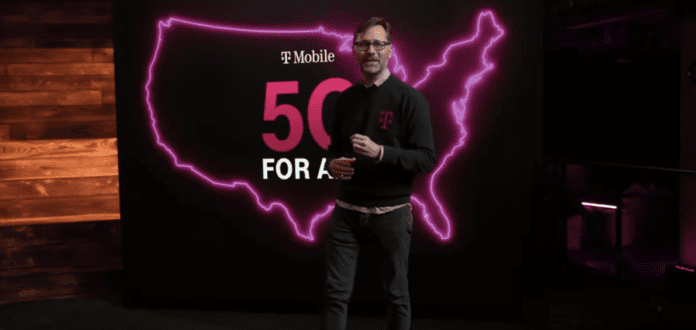From enterprise and government to rural markets and prime network seekers, T-Mobile US sees room to run beyond 2025
Speaking this week at the JP Morgan Global Technology, Media and Communications Conference in Boston, T-Mobile US CEO Mike Sievert brushed aside the doom and gloom that colors many analyses of the health of mobile network operators, and called the industry in the 5G era “productive and vibrant.” That’s certainly the case for T-Mobile US as the operator’s merger and spectrum strategy is driving growth on both the consumer and enterprise side, as well as with the addition of a cellular-backed fixed wireless access home internet service.
Now that T-Mobile US has substantively completed its integration of the former Sprint, the company’s mix of 600 MHz 5G for coverage and 2.5 GHz for capacity—not to mention operational synergies attributable to the merger—it’s taking share, Sievert said. In addition to maintaining its long-held position as a leader in value, “We’re now also the network leader and that opens up a whole new TAM for us,” Sievert said, while noting, “We’re going to defend that value proposition. We’re the value leader and we will be the value leader…But now we’re winning the hearts and minds of people that buy in this category based on network.”
Specifically on “share taking,” Sievert called out how T-Mobile US is “clipping away” at doubling its share in enterprise and government to 20%, progress toward another 20% penetration goal in smaller and rural markets that make up around 40% of the country, using it’s fixed wireless products to acquire new customers and expand ARPA from existing customers, and winning-over network seekers in the top 100 markets.
On its enterprise strategy, he said T-Mobile US is “very much on track to hit its 20% by 2025 goal. Sievert explained that enterprise buyers “don’t go on reputation,” but rather test network performance and decide based on that. “As the pieces of our business plan hit, we’re seeing business respond…Out team has got a little spring in their step that we’re seeing validation from our customers…We are not, by and large, winning based on slashing prices the most. We’re winning because they want the best network.”
He called fixed wireless access a “fantastic phenomenon and we’re still in the early innings of it.” The business is “highly profitable” with little to no additional capital outlay. Sievert said the goal there is “high single-digit penetration.”
With 5G monetization and the outlook for many operators seemingly an open question ripe for debate across the global telecoms landscape, Sievert said, “this industry is delivering the dividends on 5G that we promised. Revenues and cash flows are vibrant.”
In its most recent quarter, detailed on April 27, T-Mobile US reported 3% year-over-year growth in service revenues to $15.5 billion and net income growth of 172% year-over-year to $1.9 billion. This was driven in part by 1.3 million postpaid net customer adds and a year-over-year improvement in churn of less than 1%.

